Balbharati Maharashtra State Board 11th Commerce Maths Solution Book Pdf Chapter 9 Differentiation Miscellaneous Exercise 9 Questions and Answers.
Maharashtra State Board 11th Commerce Maths Solutions Chapter 9 Differentiation Miscellaneous Exercise 9
I. Differentiate the following functions w.r.t.x.
Question 1.
x5
Solution:
Let y = x5
Differentiating w.r.t. x, we get
\(\frac{\mathrm{d} y}{\mathrm{~d} x}=\frac{\mathrm{d}}{\mathrm{d} x} x^{5}=5 x^{4}\)
Question 2.
x-2
Solution:
Let y = x-2
Differentiating w.r.t. x, we get
\(\frac{\mathrm{d} y}{\mathrm{~d} x}=\frac{\mathrm{d}}{\mathrm{d} x}\left(x^{-2}\right)=-2 x^{-3}=\frac{-2}{x^{3}}\)
Question 3.
√x
Solution:
Let y = √x
Differentiating w.r.t. x, we get
\(\frac{\mathrm{d} y}{\mathrm{~d} x}=\frac{\mathrm{d}}{\mathrm{d} x} \sqrt{x}=\frac{1}{2 \sqrt{x}}\)
![]()
Question 4.
x√x
Solution:
Let y = x√x
∴ y = \(x^{\frac{3}{2}}\)
Differentiating w.r.t. x, we get
\(\frac{\mathrm{d} y}{\mathrm{~d} x}=\frac{\mathrm{d}}{\mathrm{d} x} x^{\frac{3}{2}}=\frac{3}{2} x^{\frac{1}{2}}\)
Question 5.
\(\frac{1}{\sqrt{x}}\)
Solution:
Let y = \(\frac{1}{\sqrt{x}}\)
∴ y = \(x^{\frac{-1}{2}}\)
Differentiating w.r.t. x, we get
\(\frac{\mathrm{d} y}{\mathrm{~d} x}=\frac{-1}{2} x^{\frac{-3}{2}}=\frac{-1}{2 x^{\frac{3}{2}}}\)
Question 6.
7x
Solution:
Let y = 7x
Differentiating w.r.t. x, we get
\(\frac{\mathrm{d} y}{\mathrm{~d} x}=\frac{\mathrm{d}}{\mathrm{d} x} 7^{x}=7^{x} \log 7\)
II. Find \(\frac{d y}{d x}\) if
Question 1.
y = x2 + \(\frac{1}{x^{2}}\)
Solution:
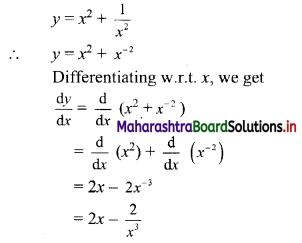
Question 2.
y = (√x + 1)2
Solution:
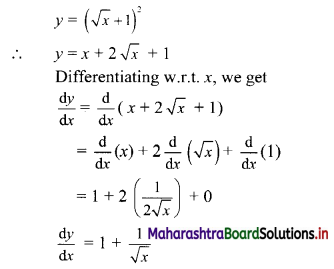
![]()
Question 3.
y = \(\left(\sqrt{x}+\frac{1}{\sqrt{x}}\right)^{2}\)
Solution:
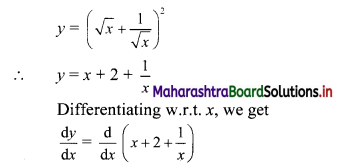
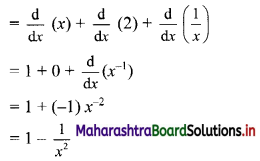
Question 4.
y = x3 – 2x2 + √x + 1
Solution:
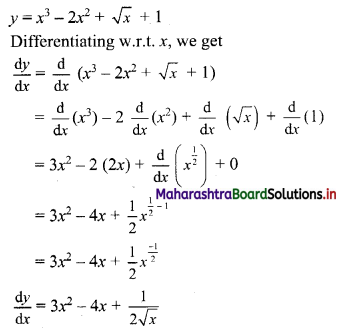
Question 5.
y = x2 + 2x – 1
Solution:
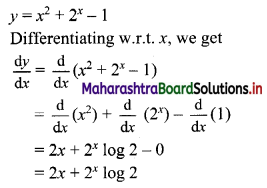
Question 6.
y = (1 – x)(2 – x)
Solution:
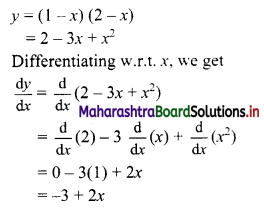
Question 7.
y = \(\frac{1+x}{2+x}\)
Solution:


![]()
Question 8.
y = \(\frac{(\log x+1)}{x}\)
Solution:
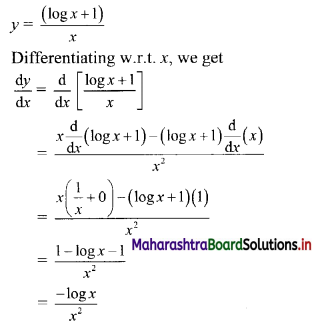
Question 9.
y = \(\frac{e^{x}}{\log x}\)
Solution:
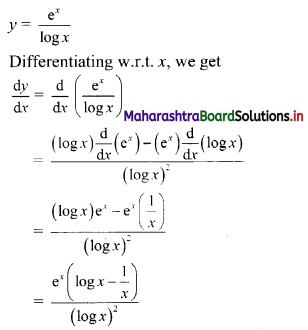
Question 10.
y = x log x (x2 + 1)
Solution:
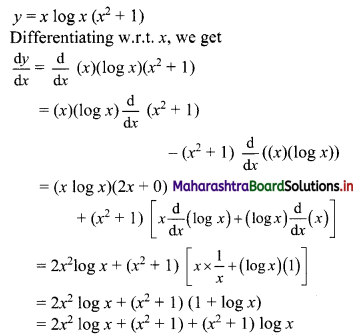
III. Solve the following:
Question 1.
The relation between price (P) and demand (D) of a cup of Tea is given by D = \(\frac{12}{P}\). Find
the rate at which the demand changes when the price is ₹ 2/-. Interpret the result.
Solution:
Demand, D = \(\frac{12}{P}\)
Rate of change of demand
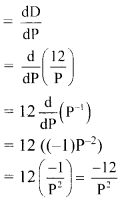
When price P = 2,
Rate of change of demand,
\(\left(\frac{\mathrm{dD}}{\mathrm{dP}}\right)_{\mathrm{P}=2}=\frac{-12}{(2)^{2}}=-3\)
∴ When the price is 2, the rate of change of demand is -3.
∴ Here, the rate of change of demand is negative demand would fall when the price becomes ₹ 2.
Question 2.
The demand (D) of biscuits at price P is given by D = \(\frac{64}{P^{3}}\), find the marginal demand
when the price is ₹ 4/-.
Solution:
Given demand D = \(\frac{64}{P^{3}}\)
Now, marginal demand
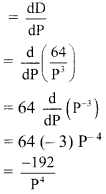
When P = 4
Marginal demand

![]()
Question 3.
The supply S of electric bulbs at price P is given by S = 2p3 + 5. Find the marginal supply when the price is ₹ 5/-. Interpret the result.
Solution:
Given, supply S = 2p3 + 5
Now, marginal supply
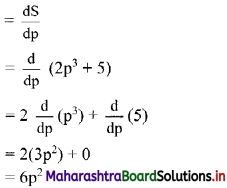
∴ When p = 5
Marginal supply = \(\left(\frac{\mathrm{dS}}{\mathrm{dp}}\right)_{\mathrm{p}=5}\)
= 6(5)2
= 150
Here, the rate of change of supply with respect to the price is positive which indicates that the supply increases.
Question 4.
The total cost of producing x items is given by C = x2 + 4x + 4. Find the average cost and the marginal cost. What is the marginal cost when x = 7?
Solution:
Total cost C = x2 + 4x + 4
Now. Average cost = \(\frac{C}{x}=\frac{x^{2}+4 x+4}{x}\)
= x + 4 + \(\frac{4}{x}\)
and Marginal cost = \(\frac{\mathrm{dC}}{\mathrm{d} x}=\frac{\mathrm{d}}{\mathrm{d} x}\)(x2 + 4x + 4)
= \(\frac{\mathrm{d}}{\mathrm{d} x}\) (x2) + 4\(\frac{\mathrm{d}}{\mathrm{d} x}\) (x) + \(\frac{\mathrm{d}}{\mathrm{d} x}\) (4)
= 2x + 4(1) + 0
= 2x + 4
∴ When x = 7,
Marginal cost = \(\left(\frac{\mathrm{d} \mathrm{C}}{\mathrm{d} x}\right)_{x=7}\)
= 2(7) + 4
= 14 + 4
= 18
Question 5.
The demand D for a price P is given as D = \(\frac{27}{P}\), find the rate of change of demand when the price is ₹ 3/-.
Solution:
Demand, D = \(\frac{27}{P}\)
Rate of change of demand = \(\frac{dD}{dP}\)
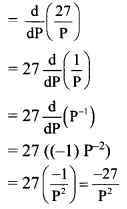
When price P = 3,
Rate of change of demand,
\(\left(\frac{\mathrm{dD}}{\mathrm{dP}}\right)_{\mathrm{P}=3}=\frac{-27}{(3)^{2}}=-3\)
∴ When price is 3, Rate of change of demand is -3.
![]()
Question 6.
If for a commodity; the price demand relation is given as D = \(\left(\frac{P+5}{P-1}\right)\). Find the marginal demand when price is ₹ 2/-
Solution:
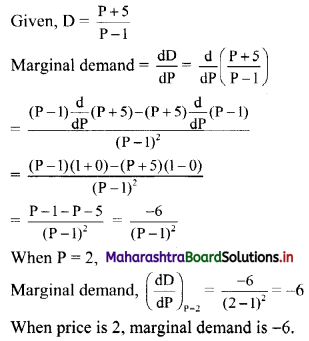
Question 7.
The price function P of a commodity is given as P = 20 + D – D2 where D is demand. Find the rate at which price (P) is changing when demand D = 3.
Solution:
Given, P = 20 + D – D2
Rate of change of price = \(\frac{dP}{dD}\)
= \(\frac{d}{dD}\)(20 + D – D2)
= 0 + 1 – 2D
= 1 – 2D
Rate of change of price at D = 3 is
\(\left(\frac{\mathrm{dP}}{\mathrm{dD}}\right)_{\mathrm{D}=3}\) = 1 – 2(3) = -5
∴ Price is changing at a rate of -5, when demand is 3.
Question 8.
If the total cost function is given by C = 5x3 + 2x2 + 1; find the average cost and the marginal cost when x = 4.
Solution:
Total cost function C = 5x3 + 2x2 + 1
Average cost = \(\frac{C}{x}\)
= \(\frac{5 x^{3}+2 x^{2}+1}{x}\)
= 5x2 + 2x + \(\frac{1}{x}\)
When x = 4,
Average cost = 5(4)2 + 2(4) + \(\frac{1}{4}\)
= 80 + 8 + \(\frac{1}{4}\)
= \(\frac{320+32+1}{4}\)
= \(\frac{353}{4}\)
Marginal cost = \(\frac{\mathrm{dC}}{\mathrm{d} x}\)
= \(\frac{d}{dx}\) (5x3 + 2x2 + 1)
= 5\(\frac{d}{dx}\) (x3) + 2 \(\frac{d}{dx}\) (x2) + \(\frac{d}{dx}\) (1)
= 5(3x2) + 2(2x) + 0
= 15x2 + 4x
When x = 4, marginal cost = \(\left(\frac{\mathrm{dC}}{\mathrm{d} x}\right)_{x=4}\)
= 15(4)2 + 4(4)
= 240 + 16
= 256
∴ The average cost and marginal cost at x = 4 are \(\frac{353}{4}\) and 256 respectively.
![]()
Question 9.
The supply S for a commodity at price P is given by S = P2 + 9P – 2. Find the marginal supply when the price is 7/-.
Solution:
Given, S = P2 + 9P – 2
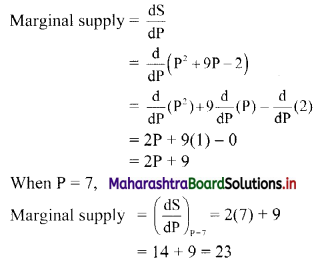
∴ The marginal supply is 23, at P = 7.
Question 10.
The cost of producing x articles is given by C = x2 + 15x + 81. Find the average cost and marginal cost functions. Find the marginal cost when x = 10. Find x for which the marginal cost equals the average cost.
Solution:
Given, cost C = x2 + 15x + 81

If marginal cost = average cost, then
2x + 15 = x + 15 + \(\frac{81}{x}\)
∴ x = \(\frac{81}{x}\)
∴ x2 = 81
∴ x = 9 …..[∵ x > 0]